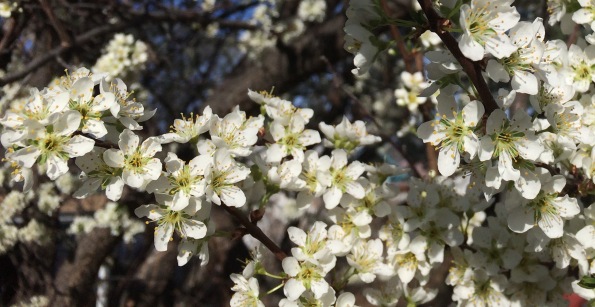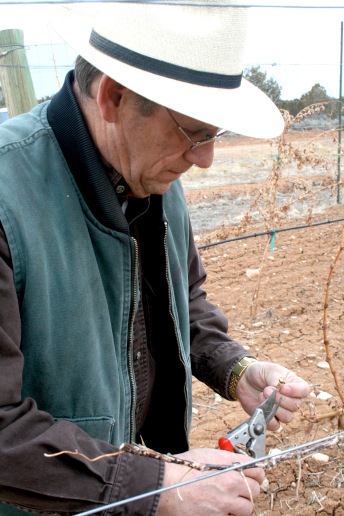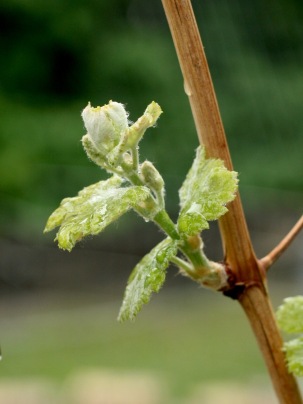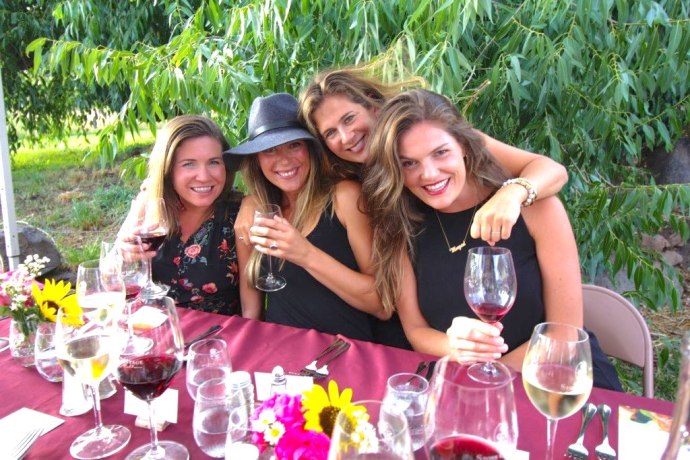Archive
It’s time for a change, but is it spring or another blast of winter?

Early heralds of the season to come, these plum blossoms may or may not survive to produce fruit, depending on the weather. Some fruit growers in western Colorado say they get plums and apricots about one year in 10. Story, photos by Dave Buchanan
A change is coming to the high desert of western Colorado. Observant hikers already have noticed miniscule blossoms poking out from desert shrubs, including such early bloomers as shadscale and saltbush.
In the city, winter-weary eyes are greeted by puffy blossoms of plum, apricot and serviceberry, glowing popcorn-white against winter-dark wood.
For fruit growers, however, this means restless nights, knowing it won’t be long until their sleep is broken by the roar of wind machines keeping the frost at bay.
Meanwhile, the vineyards sleep on. Even as eager gardeners eye emerging crocuses and dig into the cool soil as if spring were buried there, the vines wait unperturbed.
The vines are not fooled.
“Everything is still pretty much asleep,” noted Horst Caspari, state viticulturist at the CSU Orchard Mesa Research Station. “They don’t wake up very quickly. Each week they lose some of their cold-hardiness and each week they get closer to waking up.”
Caspari let his eyes wander to the apricot and pluot trees outside his window at the research station near the northwest corner of B and 32 roads on Orchard Mesa. He doesn’t harvest the fruit; the trees are there for decoration and to act as Nature’s calendar of seasons.

Winemaker Guy Drew of Guy Drew Vineyards in McElmo Canyon near Cortez in southwestern Colorado checks some early bud development in his grape vines. Growers regularly monitor bud growth and survival, looking for hints of the crop to come.
“Once the trees and vines get to bud break, all the cold hardiness changes,” he said. “Look at the apricots. I’d expect we’ll see the first flowers in the valley this week but if it drops to 29 degrees, you’ll lose them.”
Bud break, when nascent buds emerge from the protective cover and show themselves to the world, is when spring really arrives in the Grand Valley, no matter what the calendar or the thermometer says.
When a visitor remarked that his plum tree was “thisclose” to flowering, Caspari laughed.
“Well, you probably won’t have any plums to pick up this fall,” he said.
Records suggest that the last spring frosts are coming come earlier and the first fall frosts arriving later, adding a few days on each end of the Grand Valley’s growing season.
Caspari, who refers to killing frosts below 30 degrees, said that in the 54 years of records the Research Station has kept, the median date for the last frost (below 30 degrees) is April 25 while the first fall frost comes around October 23.
That’s not absolute, he emphasized.
“In 2016, we got hit pretty hard when we had 19.8 degrees on Nov. 16,” he said.
In those years, the same records indicate the valley has picked up “about a week” of frost-free (i.e., not a killing frost) growing, Caspari said.
A few days in the spring and about the same in the fall.
“We definitely have changed in the fall,” he said.
Of course, the changes are not limited to western Colorado.
NASA reports the average global temperature has increased about 0.8-degree Celsius (1.4-degrees degrees F) since 1880.
Two-thirds of that, says NASA, has occurred since 1975, just about the time U.S. wines broke onto the world’s stage at the famed Judgment of Paris.
During the 2017 Vinexpo in Bordeaux, France, growers and winemakers alike voiced concern about a warming climate and its effect on winemaking.
“Vines are very sensitive plants,” Gaia Gaja, co-owner of the 159-year old Gaja Winery in Barbaresco, Italy, told the French Press Agency. “They’re like a thermometer. They register every little variation that there is around them.”
Which brings us to spring of 2018, where things are bit behind last year.

Late March still is too early in the Grand Valley for grape tendrils but it won’t be long until delicate leaves such as these add a shade of green to brown vines.
“I keep track of the budding time of my flowers, my bulbs, and it’s been pretty fascinating,” winemaker Nancy Janes of Whitewater Hill Vineyards said recently. “It has not been unusual historically for me to have crocuses bloom in the middle of February and this year my crocuses are just blooming right now.”
She said the warm days have been balanced by nights dipping into the low 30s “and that’s keeping things pretty dormant.”
Caspari also noted that the spring so far is about two weeks behind 2017.
“Last year we had bud break in the second week of March and we don’t normally get bud break in Chardonnay until the fourth week in April,” he said.
One way to look at the spring re-awakening, said Caspari, is to envision a circle, with winter cold at the bottom and spring warmth at the top. Does the temperature rise gradually, following the arc of the circle, or is there a sudden bottom-to-top jump, bridging the gap and going quickly from winter to spring?
“That changes how you think about what you have to do to have a crop,” Caspari said.
Most grape growers are busy pre-pruning, getting ready for that last flurry of cutting and shaping when the growing season finally arrives. Will it come with a rush or will western Colorado sink back into another spell of winter, delaying the bud break and pushing development later into fall?
Nancy Janes gazed out of her winery at the still-sleeping vineyard sloping away to the north. A few clouds could be seen drifting far over the Bookcliffs in the pale, late-winter sky.
“So far, it’s been a very nice winter for us,” she said. “And you know, grapes aren’t fooled easily. They know when things are ready.”
Time for a drink? Dry winter has grape growers watching the sky

This winter has been neither extremely cold nor extremely wet, and only the first pleases grape growers. Grape vines are being freeze-dried as they lose moisture during the winter months.
If you’ve taken a stroll across your lawn recently, you know how parched things are.
January normally is a dry month for Colorado but until this past week’s smatter of moisture this winter has been especially dry. Certainly not normal, even for the high desert, and home owners in western Colorado have been urged to water trees and landscaping to prevent future damage.
But what do you do when your “landscaping” involves acres of grape vines?
The Grand Valley is no stranger to dealing with cold damage to grape vines. Hard winters (including the devastating winter of 2002/03 and most-recently in 2014) are among the challenges facing grape growers.
But this year, with daytime temperatures still climbing into the high 30s to mid- 40s (at this writing it is 48 degrees in Grand Junction) with nary a lick of snow on the ground, brings a new set of challenges.
Grape vines store a sort of anti-freeze in the form of stored sugars from last year’s photosynthesis but deep cold still can damage or kill buds, trunks and canes.
Also, a long, dry winter can desiccate older plants and kill young ones.
“We’re basically freeze-drying the vine tissue,” explained Horst Caspari, state

Except for the ground surface being dry, there’s nothing wrong with this vine a good snowstorm won’t fix.
viticulturist at Colorado State University’s Orchard Mesa Research Center. “Over the last three months we’ve had virtually no significant moisture, so it’s definitely a concern.”
While night-time temperatures aren’t far the long-term average, daytime temperature are averaging about 12 degrees above normal. Caspari said.
As any fruit grower can attest, winter damage often doesn’t show itself until spring, when warmer temperatures start the regrowth process.
“It concerns me, that’s for sure,” said grape grower Kaibab Sauvage, owner of Colorado Vineyard Specialists LLC in Palisade. “Vines can be damaged if they’re dry and they damage more easily at higher temperatures if they’re dry.”
A brochure from the University of California-Davis tells grape growers to maintain some ground moisture during dry winters in order to supply needed moisture for even bud break and flowering once vines break their winter dormancy.
Most vineyards in western Colorado get a heavy watering just prior to the irrigation canals being shut off, which usually is adequate for surviving the winter and getting a head-start for the following spring.
“We try to get the soil profile really full of water in the last week before we lose the (irrigation) water,” said Nancy Janes of Whitewater Hill Vineyards and Winery. “Around the last week of October, after we get things hardened off for the winter, we’ll blast it with water and hope it makes it pretty well through the year.”
The soil moisture also acts as insulation by filling the gaps that occur in dry soil.
“Most vines send their roots really deep, so they find water even when it’s not obvious,” Sauvage noted. “But young plants and shallow-rooted plants may be struggling right now.”
Snow also helps insulate the ground, particularly the upper few inches.
“Right now, at 6 inches down, the soil isn’t frozen and it rarely does in our part of the state,” Caspari said. “In wet soil, water is a good insulator but when you’ve had a dry period the frost penetrates much deeper and roots get damaged much easier than do buds.”
“If there was no rain or snow in the forecast, I’d rush out and water today,” he said.
Grower Galen Wallace, who has weathered some 30 winters providing grapes to Colorado’s wine industry, recently said he will be more concerned if the present conditions continue into March.
“So far, I’m not too worried,” he said. “Now, if it stays dry like this and we get some cold weather early in March, even something that’s not unusual, say lower 20s or even in the teens, it could impact our crops.”
Nancy Janes shared that sentiment, saying the mild winter so far has been pretty worry free.
“Most of our challenges seem to come from cold temperatures,” she said. “We may another month of this and then by mid-February or later is when everything starts to change.”
The damage starts to show when the vines break dormancy, Wallace said. “Growers could see a reduction in vigor, so they have to be aware of what’s happening in their vineyards.”
He advised growers to begin irrigating as soon as water is available.
“If the canals are filled on Wednesday, growers should have water running on Friday,” he said. “What worries me more right now is the lack of snow and what it might mean for late-season water.”
Sauvage and other growers in the valley have very few options when it to getting water to his vines.
“We can only hope there are some storms heading our way,” he said.
Colorado Mountain Winefest 2017: It’s hard not to smile when you’re the best wine festival in the U.S.

Jacob Helleckson of Stone Cottage Cellars in Paonia works through a tangle of arms as thirsty Festival in the Park goers pack into the Stone Cottage booth Saturday during the Colorado Mountain Winefest. More than 50 wineries were pouring their latest offerings. Story and photos by Dave Buchanan.
A full two hours before the gates opened to Saturday’s Festival in the Park, an exclamation point to the 26th annual Colorado Mountain Winefest presented by Alpine Bank, the line of ticketholders curled back beyond the sign warning would-be attendees no more tickets were available.
Stalking past the boldly lettered “Sold Out” sign, the line twisted around the corner of Pendleton Avenue and up toward William Court.
There, a traffic control sign proclaimed “Residence only”, a mixed signal only a recovering editor might notice but easily understood nonetheless.
Such a turnout has become the new norm for a wine festival recently ranked the best in the U.S. by USAToday’s 10Best list.
“I’m amazed,” said an obviously pleased Cassidee Shull, executive director of Winefest and the Colorado Association for Viticulture and Enology, on seeing the exuberant line of festival goers. “This is the third year we’ve sold out. Maybe we’re not a secret anymore.”
And she laughed.
Saturday, a lot of people were laughing. And pushing up to the 50-plus wineries, reaching for free wine, and stomping grapes, and enjoying the music and seminars and VIP tent and Colorado sunshine. Oh, did I mention reaching for free wine?
Glug, glug, went the bottles. Slurp, slurp went the crowds.

Everywhere you went during Saturday’s Colorado Mountain Winefest were winemakers pleasing thirsty wine lovers.
Admittedly, Saturday morning at the Festival in the Park is not the best time to interview winemakers, who spend most of the day with their heads down, trying to stay one bottle ahead of the hordes of wine lovers.
But even with this year’s festival blessed by clear skies, perfect temperatures and a crowd whose only two rules seemed to be No. 1 – Have fun, and No. 2 – see No. 1, something was missing.
Oh, yes. Somewhere, not too far away, was a summer’s worth of grapes screaming to be picked.
“Man, we’re right in the middle of harvest,” Garrett Portra of Carlson Vineyards said during a brief pause in the day’s nonstop bottom’s up. “We’ve already crushed 70 tons, including most of our Muscat, Gewurztraminer and Riesling and all of our Lemberger. And we should have another 50-56 tons yet to come in.”
Portra said harvest is running “at least two weeks early,” a sentiment shared by most winemakers.
“We’ve already picked 150 tons and should be getting another 250,” said Bruce Talbott, the area’s largest grape grower. “We’re right in the middle of harvest. I’ve got crews all over the valley picking grapes. Give us another three weeks and we’ll have it done.”
Last week’s short rain delay might have been a blessing for some winemakers. The wet ground prevented crews from getting into the field and opened a day for the winemakers to attend Winefest.
“There really wasn’t enough rain to make a big difference, maybe the next morning it might have been an issue, but with Winefest we didn’t have anyone to pick anyway,” said Nancy Janes of Whitewater Hill Vineyards and Winery on 32 Road. “It’s about 2-3 weeks ahead, but the grapes are looking really good, the quality is fabulous and we have beautiful consistency.”
Her report illustrates how weather differently affects the east and west ends of Orchard Mesa. While Janes said she didn’t see much hail at 32 Road, Palisade, roughly at 38 Road and pinched by the steep slopes of Mount Garfield and Grand Mesa, can see more violent weather.

Chef Wayne Smith, head instructor for the culinary program at Western Colorado Community College, carved this ice wine-luge from two 100-blocks of ice during Saturday’s Festival in the Park.
And so it was that Naomi Smith of Grande River Vineyards in Palisade said the hail came fast enough some people pulled under shelters to protect themselves and their cars.
“We haven’t been out in the fields yet to see if there was any damage,” she said. “But everything has come on fast so we’ve been back-to-back picking and pressing. There was a lot of rain but so you can’t pick right now anyway because the grapes fill with water and aren’t good for winemaking.
“But it’s OK because we’re way ahead of schedule and besides, today’s Winefest.”
Over at the ice-carving exhibit, Chef Wayne Smith of Western Colorado Community College and Travion Shinault, a student in the WCCC culinary program, were wrestling two 100-pound blocks of ice into position.
Smith’s plan was to create an icy wine luge, complete with pouring spout and a frozen likeness of Mount Garfield. He picked up a small electric chain saw and grinned at Shinault.
“Bet you never thought you’d be using one of these in culinary school, did you?” he asked the burly Shinault.
“Man, this is all new to me,” said Shinault. And he laughed.
Colorado Mtn. Winefest uncorked as best wine festival in U.S.
As if you really needed another reason to visit Colorado Mountain Winefest….
Thanks to the many fans who voted for Colorado Mountain Winefest presented by Alpine Bank, the annual celebration of Colorado wine and food, has been named the Best Wine Festival in the U.S. by USA Today.
Winefest came out on top of the other finalists in the USA Today’s 10Best website, which enlisted a panel of wine and travel experts to nominate 20 of the best festivals “celebrating wine, wine culture and wine tourism across the country’s top wine-making regions.”
“Thank you to all who voted, and for those who continue to make Colorado Mountain Winefest everything it has grown into for over 25 years.” said Cassidee Shull, Executive Director for Colorado Association for Viticulture & Enology (CAVE) and Colorado Mountain Winefest.
The 2017 Colorado Mountain Winefest presented by Alpine Bank runs Sept. 14-17 at Palisade’s Riverbend Park.
You can see the entire press release, and updated information about Winefest events and tickets, here.
A weekend of events just of you

Become one of Stone Cottage Cellars’ happy fans during this weekend’s North Fork Uncorked events. Photo courtesy of Stone Cottage Cellars.
Don’t say there’s nothing to do as spring makes way for summer.
Colorado wine country (the West Elks American Viticultural Area and the Grand Valley AVA) is celebrating the last weekend of spring (it’s also Father’s Day weekend, just sayin’) with events from book releases to special dinners and barrel tastings to wagon rides and more barrel tastings.
Friday (June 16): Author Christina Holbrook and photographer Marc Hoberman officially launch their book Winelands of Colorado from 4-6 p.m. at the Wine County Inn in Palisade. More on this and related events (fees may be charged for some events): peak1studio@gmail.com.
Saturday: Winemaker Garrett Portra of Carlson’s Vineyards releases his new River’s Edge wine at the Colorado Canyons Association’s fourth annual Crazy About Canyons fundraiser at the winery. Tickets are $75 per person and includes a picnic barbecue buffet, silent auction and special presentation by Peter Jouflas in honor of his father Chris Jouflas, who ranched in what now is McInnis Canyons NCA. Information: www.coloradocanyonsassociation.org.
Saturday/Sunday (June 17-18): The West Elks AVA celebrates North Fork Uncorked and Father’s Day Weekend in fitting style with open houses and special events at nine North Fork Valley wineries. Vineyard tours, wine tastings, and other happenings. Phone numbers (all 970 area codes) follow:
Saturday: Delicious Orchards barbecue and live music, 527-1110; Black Bridge Winery barrel tasting and tractor-pulled wagon rides, 527-6838; Stone Cottage Cellars dinner with the winemaker ($80 per person) plus live music, 527-3444.
Sunday: Brunch by Pam Petersen (live music by David Sheppard), 527-3269; Azura Cellars R/C yacht racing, 390-4251; Black Bridge Winery, barrel tastings, wagon rides, 527-6838.
Participating wineries in addition to those listed above include: 5680’, 527-6476; Leroux Creek Vineyards 872-4746; Mesa Winds Farm & Winery 250-4788; and North Fork Cellars at Delicious Orchards 527-1110.
Awaiting the return of winter

Grape vines on East Orchard Mesa haven’t yet responded to recent warm temperatures and growers are hoping for a return of cold weather to delay bud break.
On an overcast February afternoon, winemaker Bennett Price walked away from a barrel of wine he was readying to bottle and headed outside, to a fence near his DeBeque Canyon Winery where clusters of very dry grapes were shifting nervously in the breeze.
“These are Pinot Noir,” he said, reaching under the bird-proof netting drawn over the vines. “They were pretty good grapes, too, but they came on real early last spring, too early really to do anything with.”
On the third consecutive day of 60-degree plus highs, in what’s suddenly behaving as if it were the northern extension of the Colorado Banana Belt, one can be forgiven if the weather has you thinking more of mid-spring rather than mid-winter. While the sides of nearby mountains still wear thick blankets of snow, there hasn’t been any snow, or any moisture of any kind, in the lower valleys for several weeks.
Instead, here at 4,200 feet, plenty high enough for winter to return for another month or two, birds are building nests, golfers are swinging away and winter-dormant lawns are starting to green.

Bennet Price of DeBeque Canyon Winery in Palisade reaches for a sample of wine.
“I think we’re going to have an early bud break,” Price said. The unseasonal temperatures “warm up the soil too much and that stimulates the roots to start pushing.”
The temperatures, while warmer than normal – unless this is the new normal – still haven’t been consistently high enough to break the vines’ winter dormancy. It takes 50 degrees to see the return of spring, said state viticulturist Horst Caspari.
“And that’s on a 24-hour cycle, not just a quick jump up and then back to below freezing,” he said. “We’re still getting enough diurnal variation that nothing’s broken yet.”
Yet Bennet Price isn’t convinced after hearing a weather forecast calling for cooler temperatures followed by more warm days.
“We were up to 60-something yesterday and our low was 46 or something like that and today it’s back up there again,” he said. If the vines do respond to the warmth, “hopefully we won’t go back down to the low 20s or teens because you can start damaging the canes and trunks because the sap’s coming up.”
Tree-fruit growers are extremely wary of such mid-February warm spells because their trees are close enough to bud break that prolonged mild weather can bring early and unwanted development. Climate change hasn’t yet brought Western Colorado to where a heavy spring frost is out of the question.
Grapes, however, come on several weeks later than cherries, peaches and apples, which gives a bit of leeway and enough time for the weather to back to cold.
“But he’s right, the ground is being warmed up,” agreed grape grower Neil Guard at Avant Winery on East Orchard Mesa. “And look, it’s dry, there’s no snow at all. Which means if it stays warm, the vines are going to need water and we can’t get any irrigation water until April 1.”
Should the vines suffer freeze injuries, they then are susceptible to a bacterial infection called crown gall, which can eventually kill the vine.
Crown gall, caused by a bacterium that lives in the soil, also can result from mechanical injuries caused by normal vineyard maintenance such as pruning, grafting and training vines.
“I’m working in some vineyards and I have to go through and mark the vines with crown gall so they don’t prune that vine,” Price said. “You don’t want to prune that vine because if you prune it and then go to the next vine, you’re going to pass that bacterium to the next vine.”
He said the only way to treat crown gall is to pull and burn the vine and replant.
“It’s just another thing to think about if you’re planning on owning a vineyard,” Guard said, with a laugh.
– Photos, story by Dave Buchanan